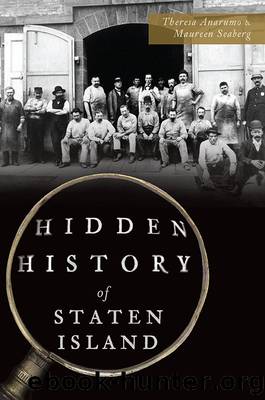Hidden History of Staten Island by Theresa Anarumo

Author:Theresa Anarumo
Language: eng
Format: epub
Publisher: Arcadia Publishing
Published: 2017-09-15T00:00:00+00:00
The Garibaldi Memorial,1932. New York Public Library Collection.
The Garibaldi-Meucci Museum today. Wikimedia Commons.
Today, the site of the Meucci home is known as the Garibaldi-Meucci Museum and is restored to the glory of its early days. Furthermore, it no longer remains within the structured columns. Opened in 1956, it is owned by the National Order Sons of Italy Foundation and run by the New York Grand Lodge Order Sons of Italy in America. It is located in the Rosebank neighborhood of Staten Island.
The Garibaldi-Meucci Museum was added to the U.S. National Register of Historic Places in 1980 and contains artifacts from Antonio Meucciâs inventions, including his model renderings, photographs, personal drawings and personal memorabilia. The giant cauldron he used in his candle-making factory is also on display. Giuseppe Garibaldiâs military uniforms and rifles are also on exhibit, along with several collections of his medals. The museum honors these outstanding Italian men and their achievements and contributions to society. The museum pays tribute to the long-standing values of Italian culture and Italian-American heritage. It offers the public classes in Italian language, guided tours, museum exhibits and lectures in Italian culture, from âLife in Ancient Romeâ to âCarnevale in Venice.â
Antonio Meucci
Antonio Meucci is the remarkable Italian inventor most known for inventing a prototype of the telephone. The controversy over whether he or Alexander Graham Bell is more deserving of its credit as inventor has been a much-debated topic for years. Although the United States credits Bell and he is the recipient of its patent, the Italian government credits Meucci with its invention.
The inventor and his wife immigrated to New York in the mid-1800s. Arriving with all their savings in hand, they moved to Staten Island, where they lived in a small cottage. Antonio Meucci operated his candle-making factory there, conducted an array of experiments and developed many inventions. One specific invention was the development of a voice-communication model, which many credit as the first telephone.
Meucci dedicated some of the rooms in his home for his candle-making factory and had a laboratory in his basement for his experiments. Much of his savings were spent on patents and their expensive application fees for his many inventions, and as a result, much of his money dwindled through the course of the years.
In 1856, Meucci began experimenting with electromagnetic transmissions using voice through the wires. These principles were based on his scientific experiments conducted within the confines of his home, as mentioned in Sandra Meucciâs Antonio and the Electric Scream. The book states that Meucci designed a device that allowed his voice to transmit from his laboratory in the basement to his bedridden wife on the second floor of the home. Some of his notes, from âHistory of the House,â describe his principal thoughts: âIt consists of a vibrating diaphragm and an electrified magnet with a spiral wire that wraps around it. The vibrating diaphragm alters the current of the magnet. These alterations of current, transmitted to the other end of the wire, create analogous vibrations of the receiving diaphragm and reproduce the word.
Download
This site does not store any files on its server. We only index and link to content provided by other sites. Please contact the content providers to delete copyright contents if any and email us, we'll remove relevant links or contents immediately.
Kathy Andrews Collection by Kathy Andrews(10519)
The remains of the day by Kazuo Ishiguro(7551)
Spare by Prince Harry The Duke of Sussex(4195)
Paper Towns by Green John(4169)
The Body: A Guide for Occupants by Bill Bryson(3800)
Be in a Treehouse by Pete Nelson(3211)
Harry Potter and the Goblet Of Fire by J.K. Rowling(3041)
Goodbye Paradise(2961)
Never by Ken Follett(2880)
Into Thin Air by Jon Krakauer(2701)
The Remains of the Day by Kazuo Ishiguro(2617)
The Genius of Japanese Carpentry by Azby Brown(2609)
The Cellar by Natasha Preston(2595)
Drawing Shortcuts: Developing Quick Drawing Skills Using Today's Technology by Leggitt Jim(2532)
120 Days of Sodom by Marquis de Sade(2436)
Architecture 101 by Nicole Bridge(2350)
The Man Who Died Twice by Richard Osman(2297)
Machine Learning at Scale with H2O by Gregory Keys | David Whiting(2289)
Fairy Tale by Stephen King(2069)
